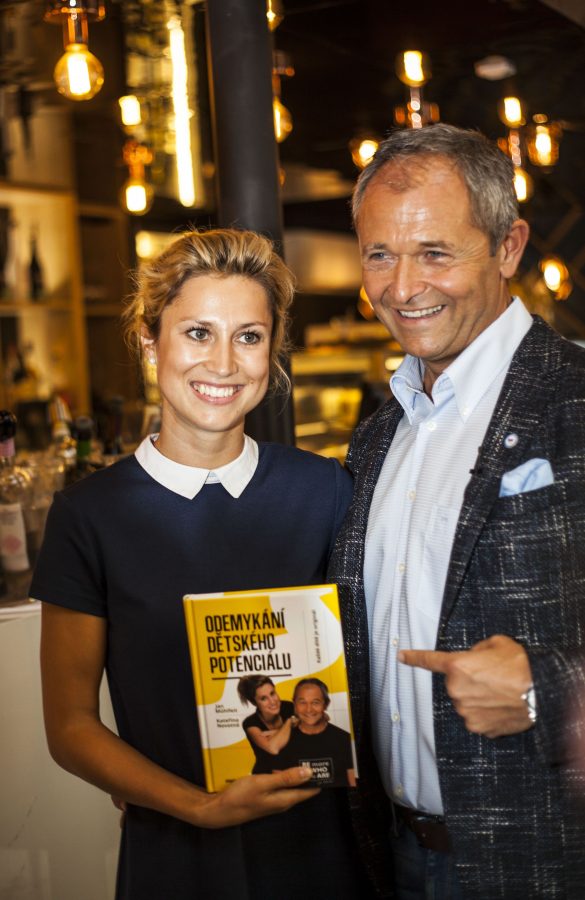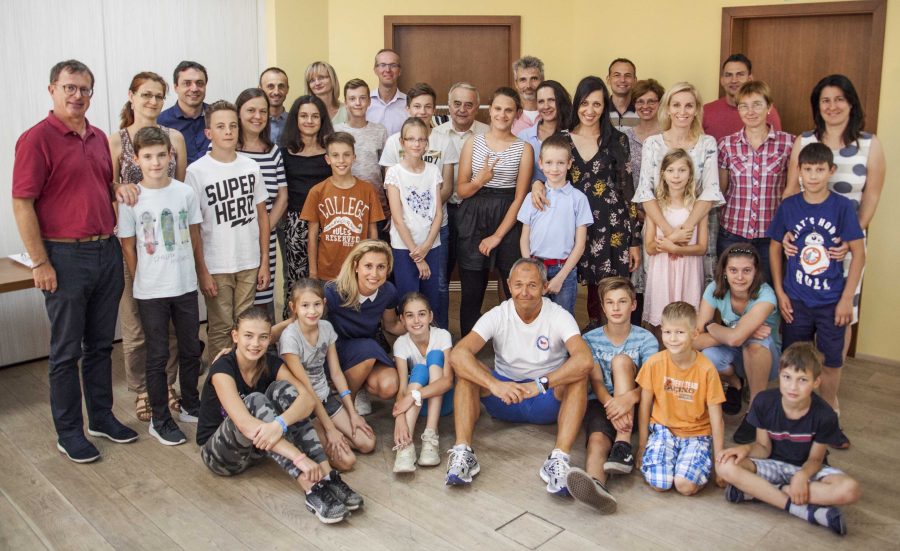
Kateřina Novotná, Jan Mühlfeit. More information to be found via www.janmuhlfeit.com and www.odemykanidetskehopotencialu.cz
A few years ago, when we met for the first time, neither of us had ever imagined the path that had been awaiting us. However, we soon realized that we will walk this path together. Within a very short time we managed to combine our knowledge and create a unique system for the education of parents and their children. Now for more than two years we have been conducting special workshops for children and students aimed at developing their talents; it’s been a joy to have nearly three thousand participants in these workshops.
Due to the quality responses received, we have decided to expand the program a little further and make our experience even more accessible to people. All our accumulated knowledge and effective methods, which are key to the proper use of our strengths are condensed in more than two hundred pages of our new book entitled Unlocking Children’s Potential that we launched on October 1st.
In the book, we discuss not only discovering what is in us, but also the functioning of brain synapses, creating synergies and building self- confidence. Parents and educators will be able to see how the latest findings of positive psychology help children in their development and self-awareness, which lead not only to success, but also to happiness in their life.
Why is self-knowledge important?
It’s simple: when we do what we are good at and what we enjoy, we feel good and are able to perform better. Feeling good and enjoying learning and work help prevent stress or the accumulation of negative emotions.
Where to begin to learn how to find out what our talents are? And how to help children to discover them?
For these purposes, psychometric talent tests have been developed. These tests contain statements and examples of real life situations, from which we select those responses that best define us. Most of these tests are based on the intuitive responses and preferences of each respondent. The results will highlight which areas are the strongest and where we could succeed.
For those who do not want to go through the tests, there are also simple exercises in which we ask ourselves what gives us energy and what helps us recharge. Such activities are likely to overlap with areas of our talents.
It is natural to have both strengths and weaknesses. Identification of our weaknesses helps us: these are activities that we should learn at least at such a level that they do not limit us in the future. However, these are not areas that we should focus on in life. Additionally, it’s important to recognize that this is why there are diverse work teams. We continue to work with strengths and talents – through verification, development and learning how to use them best.
Discovering hidden talent
We believe that every child has a talent. Discovering their talent is the first and crucial step on the path to success. It’s just as important as nurturing the talent and developing it further. Obsolete thinking systems in this area sometimes hinder, instead of supporting strengths, children in schools learn to be better at what they struggle with.
When a baby is born, it has hundreds of millions of brain cells, called neurons, which communicate with each other and connect through synapses. These are then activated by the innate talents. Children mostly play with what is fun for them. Why is it like this? These synapses are linked to two formulas. In the first one, they play the role of enjoyment, experience and what surrounds humans. In the second one, it is linked to what humans think about.
By the age of three, the child has already created half of their synapses; by the seventh year there are almost complete connections. If the discovery of talent happens later than that, it can still be extremely useful. Thanks to brain neuroplasticity, a process where new synapses are created, our brain can be “reprogrammed” at any time. It’s just slower than in childhood.
Talent instead of compass
It makes no sense to give ourselves only the highest goals, instead we must give ourselves the right ones. When a person does something to succeed and has a natural talent, they are not only successful but also happy because they are engaged in areas that engage them. It is therefore necessary to have a balance of motivation (external incentives that motivate us) together with inspiration (i.e., an internal motivation that is characterized by love for a certain activity). You can receive gold medals, make money, receive golden globes and you can have fun. Jaromír Jágr was recently interviewed by Forbes in the Czech Republic and the journalist asked him: “Jaromír, how can you be motivated to perform after all these years?” And he said: “You didn’t understand what this is about. It’s not just about external motivation.” The essence lies in that journey because he simply loves hockey.
The talent that is genetically given to us by our ancestors is the potential. If we do not find it, we will not be able to unlock it. We try to not only discover the talent, but also to show how to develop it. Only by means of talent can you achieve the so-called state of flow, where even if you are doing something complicated, your talents make the most of it. When in flow, people are not only successful, but also happy because they are themselves.

School as an obstacle course
According to NASA, 98% of children at the age of six show very high creativity. By the age of ten, it’s been reduced to 30% and during puberty it is only 15%. At school there is no time or space for creativity. School does not allow thoughtful questions or the search for innovative or “out of the box” solutions and angles to issues. That kind of thinking is extremely important. Many teachers seek the fastest way to achieve the prescribed outcome, which is a fulfilled goal for them, but that doesn’t mean it is also a fulfilled goal for children.
Knowledge itself is not as important as how one can relate to and apply the actual knowledge. However, the school teaches pupils in boxes – one contains mathematics, another history and the third language, but they are not linked to each other. Nowadays, information is easily accessible, but the competitive advantage lies in what you are able to do with that data.
The last but not least problem that obstructs developing children’s potential is the desire to improve children’s weaknesses. People are afraid of failure, therefore, in the ratio of 10: 1 they try to break their weaknesses, often at the expense of developing talents. However, the ratio should be exactly the opposite. Only ten to twenty percent of a person’s time and energy should be devoted to improving their weaknesses. The rest of their time and energy should be focused on what they are particularly good at and develop their strengths.
Publication as a guide
The book Unlocking Children’s Potential helps to fill these shortcomings and serves as a guide for parents who want something more for themselves and their children. Our mission is to help parents and children discover talents so that they can live better lives and be happy, successful and satisfied with themselves. This is why we conduct our courses, and have written a book which provides detailed elaboration, extension and specification.
The publication is supplemented by a series of interviews with personalities such as violin virtuoso Jaroslav Svěcený, psychiatrist Cyril Höschl and Dagmar Svobodová, mother of three successful sons. They share about their children, talents and life experiences. Therefore, every reader should be able to find a part that inspires them and leads to better self- knowledge.
By Jan Mühlfeit, Global Strategist, Coach and Mentor,
former Microsoft Chairman for Europe

